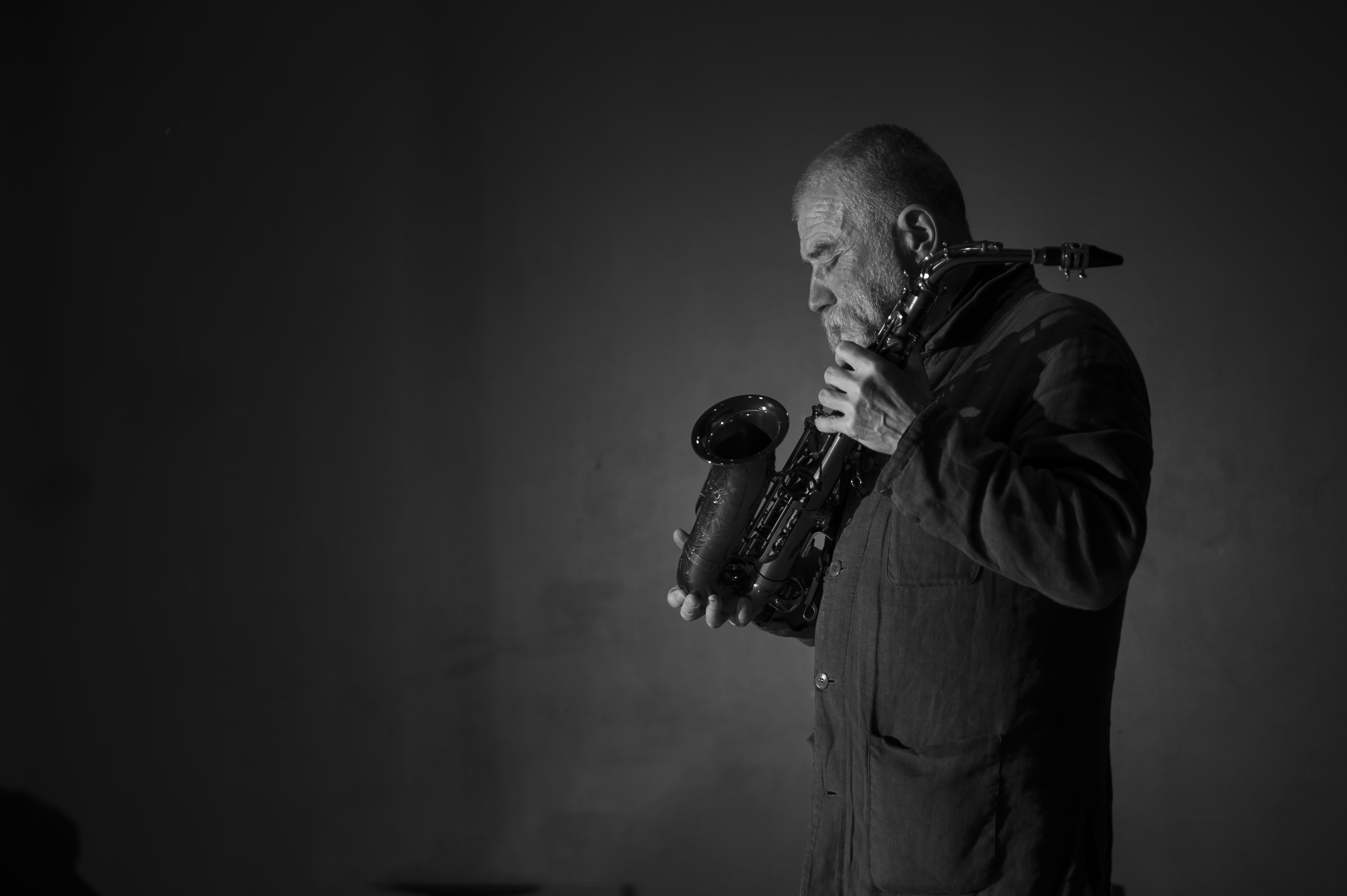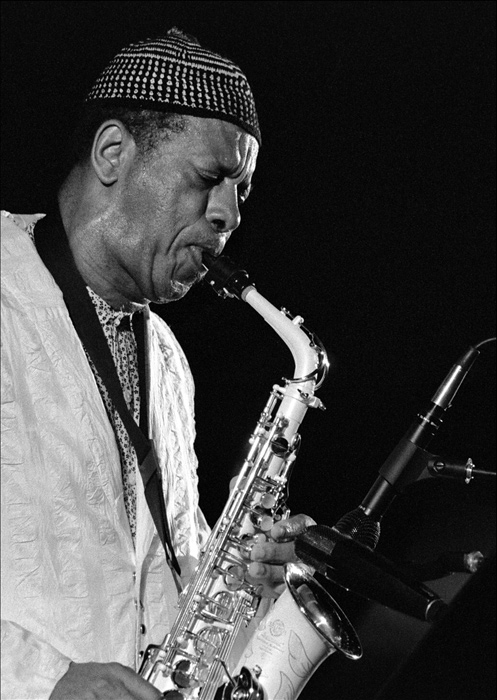|
Historic Music Past Tense Future
''Historic Music Past Tense Future'' is a double-LP live album by saxophonist Peter Brötzmann, drummer Milford Graves, and bassist William Parker. It was recorded in March 2002 at CB's 313 Gallery in New York City, and was released in 2022 by Black Editions Archive, a label focused on historical free jazz, with emphasis on the release of previously unavailable recordings by Graves. Reception Giovanni Russonello of '' The New York Times'' included the album in the publication's weekly playlist of notable new music, calling the musicians "lions of the avant-garde." ''The Free Jazz Collectives Stuart Broomer awarded the album 5 stars, and commented: "This is one of those recordings that might be welcomed with simply respectful silence and celebration, or you might want to shout along at times... it's a kind of simultaneous Jeremiad and Hymn of Praise, for all the life missed, all the life lived and all the life possible, a vast collective utterance that has passed beyond all noti ... [...More Info...] [...Related Items...] OR: [Wikipedia] [Google] [Baidu] |
Peter Brötzmann
Peter Brötzmann (born 6 March 1941) is a German saxophonist and clarinetist. Biography Early life Brötzmann was born in Remscheid, North Rhine-Westphalia, Germany. He studied painting in Wuppertal and was involved with the Fluxus movement but grew dissatisfied with art galleries and exhibitions. He experienced his first jazz concert when he saw American jazz musician Sidney Bechet while still in school at Wuppertal, and it made a lasting impression. He has not abandoned his art training. Brötzmann has designed most of his album covers. He taught himself to play clarinets, then saxophones; he is also known for playing the tárogató. Among his first musical partnerships was with double bassist Peter Kowald. '' For Adolphe Sax'', Brötzmann's first recording, was released in 1967 and featured Kowald and drummer Sven-Åke Johansson. In 1968 ''Machine Gun'', an octet recording, was released. The album was self-produced under his BRO record label imprint and sold at concerts, ... [...More Info...] [...Related Items...] OR: [Wikipedia] [Google] [Baidu] |
Milford Graves
Milford Graves (August 20, 1941 – February 12, 2021) was an American jazz drummer, percussionist, Professor Emeritus of Music, researcher/inventor, visual artist/sculptor, gardener/herbalist, and martial artist. Graves was noteworthy for his early avant-garde contributions in the 1960s with Paul Bley, Albert Ayler, and the New York Art Quartet, and is considered to be a free jazz pioneer, liberating percussion from its timekeeping role. The composer and saxophonist John Zorn referred to Graves as "basically a 20th-century shaman." Early life Graves was born in Jamaica, Queens, New York City, on August 20, 1941. He began playing drums when he was three years old, and was introduced to the congas at age eight. He also studied timbales and African hand drumming at an early age. By the early 1960s, he was leading dance bands and playing in Latin/Afro Cuban ensembles in New York on bills alongside Cal Tjader and Herbie Mann. His group, the Milford Graves Latino Quintet, included s ... [...More Info...] [...Related Items...] OR: [Wikipedia] [Google] [Baidu] |
William Parker (musician)
William Parker (born January 10, 1952) is an American free jazz double bassist. Beginning in the 1980s, Parker played with Cecil Taylor for over a decade, and he has led the Little Huey Creative Music Orchestra since 1981. ''The Village Voice'' named him "the most consistently brilliant free jazz bassist of all time" and ''DownBeat'' has called him "one of the most adventurous and prolific bandleaders in jazz". Early life and career Parker was born in the Bronx, New York City, and grew up in the Melrose housing project. His first instrument was the trumpet, followed by the trombone and cello. Parker was not formally trained as a classical player, but in his youth studied with Jimmy Garrison, Richard Davis, and Wilbur Ware in learning the tradition. While Parker has been active since the early 1970s, he first came to public attention playing with pianist Cecil Taylor in the 1980s. He has performed in many of Peter Brötzmann's groups, and played with saxophonist David S. W ... [...More Info...] [...Related Items...] OR: [Wikipedia] [Google] [Baidu] |
CBGB
CBGB was a New York City music club opened in 1973 by Hilly Kristal in Manhattan's East Village. The club was previously a biker bar and before that was a dive bar. The letters ''CBGB'' were for '' Country'', '' BlueGrass'', and '' Blues'', Kristal's original vision, yet CBGB soon became a famed venue of punk rock and new wave bands like the Ramones, Television, Patti Smith Group, Blondie, and Talking Heads. From the early 1980s onward, CBGB was known for hardcore punk. One storefront beside CBGB became the "CBGB Record Canteen", a record shop and café. In the late 1980s, "CBGB Record Canteen" was converted into an art gallery and second performance space, "CB's 313 Gallery". CB's Gallery was played by music artists of milder sounds, such as acoustic rock, folk, jazz, or experimental music, such as Dadadah, Kristeen Young and Toshi Reagon, while CBGB continued to showcase mainly hardcore punk, post punk, metal, and alternative rock. 313 Gallery was also the host location ... [...More Info...] [...Related Items...] OR: [Wikipedia] [Google] [Baidu] |
Free Jazz
Free jazz is an experimental approach to jazz improvisation that developed in the late 1950s and early 1960s when musicians attempted to change or break down jazz conventions, such as regular tempos, tones, and chord changes. Musicians during this period believed that the bebop, hard bop, and modal jazz that had been played before them was too limiting. They became preoccupied with creating something new and exploring new directions. The term "free jazz" has often been combined with or substituted for the term "avant-garde jazz". Europeans tend to favor the term "free improvisation". Others have used "modern jazz", "creative music", and "art music". The ambiguity of free jazz presents problems of definition. Although it is usually played by small groups or individuals, free jazz big bands have existed. Although musicians and critics claim it is innovative and forward-looking, it draws on early styles of jazz and has been described as an attempt to return to primitive, often re ... [...More Info...] [...Related Items...] OR: [Wikipedia] [Google] [Baidu] |
The New York Times
''The New York Times'' (''the Times'', ''NYT'', or the Gray Lady) is a daily newspaper based in New York City with a worldwide readership reported in 2020 to comprise a declining 840,000 paid print subscribers, and a growing 6 million paid digital subscribers. It also is a producer of popular podcasts such as '' The Daily''. Founded in 1851 by Henry Jarvis Raymond and George Jones, it was initially published by Raymond, Jones & Company. The ''Times'' has won 132 Pulitzer Prizes, the most of any newspaper, and has long been regarded as a national " newspaper of record". For print it is ranked 18th in the world by circulation and 3rd in the U.S. The paper is owned by the New York Times Company, which is publicly traded. It has been governed by the Sulzberger family since 1896, through a dual-class share structure after its shares became publicly traded. A. G. Sulzberger, the paper's publisher and the company's chairman, is the fifth generation of the family to head the pa ... [...More Info...] [...Related Items...] OR: [Wikipedia] [Google] [Baidu] |
Stuart Broomer
Stuart Broomer is a Canadian editor, music critic, pianist, writer, jazz historian, and composer. He is a former editor with ''CODA'' magazine and currently works as an editor at Coach House Books. As a music critic he has written articles for Amazon.com, ''The Globe and Mail'', ''Toronto Life'', ''Down Beat'', ''Musicworks'', ''Cadence Magazine'', '' ParisTransatlantlic'' and '' Signal to Noise''. He has also authored more than 60 liner essays for musicians internationally. His book ''Time and Anthony Braxton'' () was published by The Mercury Press in 2009. He is a member of the music faculty at George Brown College. Broomer is a graduate of The Royal Conservatory of Music where he studied music composition and piano with Samuel Dolin. As a pianist, he is best known for playing in the jazz trio "Broomer, Mars & Smith" in the 1970s and later the duo "Stuart Broomer & John Mars" during the 1980s, both of which included compositions by Broomer in their repertoire. The duo released a ... [...More Info...] [...Related Items...] OR: [Wikipedia] [Google] [Baidu] |
The Quietus
''The Quietus'' is a British online music and pop culture magazine founded by John Doran and Luke Turner. The site is an editorially independent publication led by Doran with a group of freelance journalists and critics. Content ''The Quietus'' primarily features writings on music and film, as well as interviews with a wide range of notable artists and musicians. The magazine also occasionally includes pieces on literature, graphic novels, architecture, and TV series. The website is edited by John Doran, who claims that it caters for "the intelligent music fan between the age of 21 and, well, 73". Its staff list includes former writers for publications such as '' Melody Maker'', '' Select'', ''NME'' and '' Q'', including journalist David Stubbs, BBC Radio 1 DJ Steve Lamacq, Professor Simon Frith and Simon Price among others. Among its best known columns is its "Baker's Dozen," in which artists select 13 personal favourite albums. Content from the site's interviews have been ... [...More Info...] [...Related Items...] OR: [Wikipedia] [Google] [Baidu] |
Peter Margasak
Peter Margasak is a music critic, journalist, and artistic director of the annual Frequency Festival in Chicago, an event that grew out of his longstanding work programming the weekly Frequency Series for experimental music, experimental, improvised music, improvised, and contemporary classical music, contemporary classical music. Margasak wrote for the ''Chicago Reader'' for 25 years. Career Margasak writes about disparate musical times and communities within the broad field of late-20th and 21st-century music. His contributions to ''The New York Times'' include a piece about Algerian "pop Raï, rai" artist Khaled Brahim and another on the Avant-garde music, avant-garde artists of the Theatre of Eternal Music and their battles for proprietorship of drone music; a ''Pitchfork (website), Pitchfork'' feature on the year 1979 in Chicago touches on both power pop and the racial dimensions of anti-disco sentiment during "the Rise of House music, House Music"; he has written about tri ... [...More Info...] [...Related Items...] OR: [Wikipedia] [Google] [Baidu] |
Stereogum
''Stereogum'' is a daily Internet publication that focuses on music news, reviews, interviews, and commentary. The site was created in January 2002 by Scott Lapatine. ''Stereogum'' was one of the first MP3 blogs and has received several awards and citations, including the PLUG Award for Music Blog of the Year, ''Blender''s Powergeek 25, and ''Entertainment Weekly''s Best Music Websites. The site was named an Official Honoree of the Webby Awards in the music category and won the OMMA Award for Web Site Excellence in the Entertainment/Music category. In 2011, ''Stereogum'' won ''The Village Voice''s Music Blog of the Year. History The site was named after a lyric from the song "Radio #1" by the French electronic duo Air. In late 2006, ''Stereogum'' received an influx of capital through Bob Pittman's private investment entity The Pilot Group. In November 2007, it was purchased by SpinMedia (formerly known as Buzz Media). April 2008 saw the launch of '' Videogum'', a sister si ... [...More Info...] [...Related Items...] OR: [Wikipedia] [Google] [Baidu] |




.png)